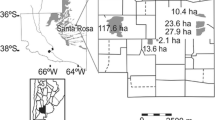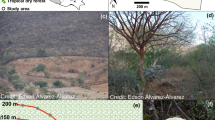Abstract
Avian nest predation is known to increase with the degree of forest fragmentation. A common explanation is that farmland allows for high densities of generalist predators, and predators penetrating into the forest cause higher nest losses at forest-farmland edges than in forest interiors. In contrast to numerous patch-level studies of forest edge effects conducted earlier, we broadened the spatial extent to the landscape. We tested the hypothesis of increased predation near farmland over distances of >4 km from forest–farmland edges into forest interiors in five mountain ranges in Germany, using artificial ground nests. We considered two landscape settings: (1) Transitions between a forest matrix and a farmland matrix, and (2) farmland patches within a forest matrix. Nest losses were not significantly higher in vicinity to a farmland matrix, but proximity to a pasture within the forest matrix strongly increased predation risk. We speculate that these differences resulted from landscape geometry. Farmland patches and matrix alike are highly attractive to generalist predators, and are regularly visited by red foxes from the forest. Predators that traverse the forest and take prey along the way, will cause a concentration of predation risk towards a patch (pasture), but not towards an adjacent matrix (farming lowlands), of feeding habitat. Contrary to previous evidence that edge effects in nest predation level off after 50 m, nest fate was related to distance to pastures across the entire study extent of 4.1 km. Our results suggest that landscape context and predator mobility may greatly affect spatial predation patterns.
Similar content being viewed by others
References
H. Andrén (1992) ArticleTitleCorvid density and nest predation in relation to forest fragmentation: a landscape perspective Ecology 73 794–804
H. Andrén (1995) Effects of landscape composition on predation rates at habitat edges L. Hansson L. Fahrig G. Merriam (Eds) Mosaic Landscapes and Ecological Processes Chapman and Hall London UK 225–255
H. Andrén P. Angelstam (1988) ArticleTitleElevated predation rates as an edge effect in habitat islands: experimental evidence Ecology 69 544–547
H. Andrén P. Angelstam E. Lindström P. Widén (1985) ArticleTitleDifferences in predation pressure in relation to habitat fragmentation Oikos 45 273–277
P. Angelstam (1986) ArticleTitlePredation on ground-nesting birds nests in relation to predator densities and habitat edge Oikos 47 365–373
Bang P. and Dahlström P. 1986. Tierspuren. BLV Bestimmungsbuch 9. BLV Verlagsgesellschaft. München, Germany.
H.-G. Bauer P. Berthold P. Boye W. Knief P. Südbeck K. Witt (2002) ArticleTitleRote Liste der Brutvögel Deutschlands. 3., revised version Berichte Vogelschutz 39 13–60
P. Batáry A. Báldi (2004) ArticleTitleEvidence of an edge effect on avian nest success Conservation Biology 18 389–400 Occurrence Handle10.1111/j.1523-1739.2004.00184.x
E.M. Bayne K.A. Hobson (1997) ArticleTitleComparing the effects of landscape fragmentation by forestry and agriculture on predation of artificial nests Conservation Biology 11 1418–1429 Occurrence Handle10.1046/j.1523-1739.1997.96135.x
Berberich W. 1992. Das Raum-Zeit System des Rotfuchses. Berchtesgaden National Park Research Report 17. Berchtesgaden National Park, Berchtesgaden, Germany.
T.M. Bergin L.B. Best K.E. Freemark K.J. Koehler (2000) ArticleTitleEffects of landscape structure on nest predation in roadsides of a Midwestern agro ecosystem: a multiscale analysis Landscape Ecology 15 131–143 Occurrence Handle10.1023/A:1008112825655
D.M. Burke K. Elliott L. Moore W. Dunford E. Nol J. Phillips S. Holmes K. Freemark (2004) ArticleTitlePatterns of nest predation on artificial and natural nests in forests Conservation Biology 18 381–388 Occurrence Handle10.1111/j.1523-1739.2004.00014.x
A.D. Chalfoun F.R. Thompson SuffixIII M.J. Ratnaswamy (2002) ArticleTitleNest predators and fragmentation: a review and meta-analysis Conservation Biology 16 306–318 Occurrence Handle10.1046/j.1523-1739.2002.00308.x
L.M. Curran I. Caniago G.D. Paoli D. Astianti M. Kusneti M. Leighton C.E. Nirarita H. Haeruman (1999) ArticleTitleImpact of El Nino and logging on canopy tree recruitment in Borneo Science 286 2184–2188 Occurrence Handle10.1126/science.286.5447.2184 Occurrence Handle10591655
InstitutionalAuthorNameDJV (Deutscher Jagdschutz-Verband) (1994) DJV Handbuch 1994 Verlag Dieter Hoffmann Mainz, Germany
InstitutionalAuthorNameDJV (Deutscher Jagdschutz-Verband) (2004) DJV Handbuch 2004 Verlag Dieter Hoffmann Mainz, Germany
T.M. Donovan P.W. Jones E.M. Annand F.R. Thompson SuffixIII (1997) ArticleTitleVariation in local-scale edge effects: mechanisms and landscape context Ecology 78 2064–2075
D.J. Flaspohler S.A. Temple R.N. Rosenfield (2001) ArticleTitleEffects of forest edges on ovenbird demography in a managed forest landscape Conservation Biology 15 173–183 Occurrence Handle10.1046/j.1523-1739.2001.99397.x
R.T.T. Forman L.E. Alexander (1998) ArticleTitleRoads and their major ecological effects Annual Review Ecology and Systematics 29 207–231 Occurrence Handle10.1146/annurev.ecolsys.29.1.207
C. Janko (2003) Habitatnutzung des Rotfuchses (Vulpes vulpes) in Dörfern und Kleinstädten University of Hohenheim Germany
T. Kaphegyi (2002) Untersuchungen zum Sozialverhalten des Rotfuchses (Vulpes vulpes L.) University of Freiburg Germany 95
M.J. Hartley M.L. Hunter SuffixJr. (1998) ArticleTitleA meta-analysis of forest coveredge effects, and artificial nest predation rates Conservation Biology 12 465–469 Occurrence Handle10.1046/j.1523-1739.1998.96373.x
Heibl C. 2003. Das Raum-Zeit- Verhalten von Rotfüchsen Vulpes vulpes in suburbanem GebietGemeinde Grünwald bei München. Diploma Thesis. Technical University of Munich.
E. Huhta T. Mappes J. Jokimäki (1996) ArticleTitlePredation on artificial ground nests in relation to forest fragmentation, agricultural land and habitat structure Ecography 19 85–91
P. Kareiva (1987) ArticleTitleHabitat fragmentation and the stability of predator–prey interactions Nature 326 388–390 Occurrence Handle10.1038/326388a0
Knauer F. and Storch I. 2001. Übersicht zur Prädatorenforschung. Teil I, Literaturübersicht. Unpublished report for the Bavarian State Ministry of Agriculture. Munich Wildlife Society, Ettal, Germany, pp. 200
S. Kurki A. Nikula P. Helle H. Lindén (2000) ArticleTitleLandscape fragmentation and forest composition effects on grouse breeding success in boreal forests Ecology 81 1985–1997
S. Kurki H. Lindén (1995) ArticleTitleForest fragmentation due to agriculture affects the reproductive success of ground-nesting black grouse Tetrao tetrix Ecography 18 109–113
D.C. Lahti (2001) ArticleTitleThe ‘edge effect on nest predation’ hypothesis after twenty years Biological Conservation 99 365–374 Occurrence Handle10.1016/S0006-3207(00)00222-6
W.F. Laurance (2000) ArticleTitleDo edge effects occur over large spatial scales? Trends in Ecology and Evolution 15 134–135 Occurrence Handle10.1016/S0169-5347(00)01838-3 Occurrence Handle10717681
P. Larivere (1999) ArticleTitleReasons why predators cannot be inferred from nest remains The Condor 101 718–721
W.Z. Lidicker SuffixJr. (1999) ArticleTitleResponses of mammals to habitat edges: an overview Landscape Ecology 14 333–343 Occurrence Handle10.1023/A:1008056817939
Lindström J., Rintamäki P.T. and Storch I. 1998. Black grouse. BWP Update. The journal of birds of the Western Palearctic (Oxford University Press, Oxford, UK) 2: 173–191.
D. MacDonald (1977) ArticleTitleOn food preferences in the red fox Mammal Review 7 7–23
R.E. Major C.E. Kendal (1996) ArticleTitleThe contribution of artificial nest experiments to understanding avian reproductive success: a review of methods and conclusions Ibis 138 298–307
A.P. Møller (1989) ArticleTitleNest site selection across field-woodland ecotones: the effect of nest predation Oikos 56 240–246
T. Oksanen L. Oksanen M. Gyllenberg (1992) ArticleTitleExploitation ecosystems in heterogeneous habitat complexes. II. Impact of small-scale heterogeneity on predator–prey dynamics Evolutionary Ecology 6 383–398
T. Oksanen M. Schneider (1995) Predator–prey dynamics as influenced by habitat heterogeneity W.Z. Lidicker SuffixJr. (Eds) Mammalian Ecology and Conservation University of Minnesota Press Minneapolis, USA 122–150
P.W. Paton (1994) ArticleTitleThe effect of edge on avian nest success: how strong is the evidence? Conservation Biology 8 17–26 Occurrence Handle10.1046/j.1523-1739.1994.08010017.x
H.A. Peters (2001) ArticleTitleClidemia hirta invasion at the Pasoh Forest Reserve: an unexpected plant invasion in an undisturbed tropical forest Biotropica 33 60–68
P.J. Pietz D.A. Granfors (2000) ArticleTitleIdentifying predators and fates of grassland passerine nests using miniature video cameras Journal of Wildlife Management 64 71–87
Reynolds J.C. 1990. The impact of generalist predators on gamebird populations. In: Lumeij J.T. and Hoogeveen Y.R. (eds), in the Netherlands. Organisatiecommissie Nederlandse Wilde Hoenders, Amersfoort, The Netherlands, pp. 172–184.
S.K. Robinson F.R. Thompson SuffixIII T.M. Donovan D.R. Whitehead J. Faaborg (1995) ArticleTitleRegional forest fragmentation and the nesting success of migratory birds Science 267 1987–1990
A.D. Rodewald R.H. Yahner (2001) ArticleTitleInfluence of landscape composition on avian community structure and associated mechanisms Ecology 82 3493–3504
Russell A.J.M. and Storch I. 2004. Summer food composition of red fox and pine marten in the German Alps. European Journal of Wildlife Research 50 (online first). DOI: 10.1007/s10344–004–0037–0.
T. Storaas (1988) ArticleTitleA comparison of losses in artificial and naturally occurring capercaillie nests Journal of Wildlife Management 52 123–126
T. Storaas P. Wegge (1987) ArticleTitleNesting habitats and nest predation in sympatric populations of Capercaillie and Black Grouse Journal of Wildlife Management 51 167–172
Storch I. 2001. Capercaillie. BWP Update. The journal of birds of the Western Palearctic (Oxford University Press, Oxford, UK) 3: 1–24.
I. Storch C. Kleine (1991) ArticleTitleZur Nahrungswahl des Fuchses in den Alpen (The diet of the red fox in the Alpine foothills) Zeitschrift für Jagdwissenschaft 37 267–270
I. Storch (1991) ArticleTitleHabitat fragmentation, nest site selection, and nest predation risk in capercaillie Ornis Scandinavica 22 213–217
I. Storch (1994) ArticleTitleHabitat and survival of capercaillie nests and broods in the Bavarian Alps Biological Conservation 70 237–243 Occurrence Handle10.1016/0006-3207(94)90168-6
I. Storch C. Leidenberger (2003) ArticleTitleTourismmountain huts and the distribution of corvids in the Alps Wildlife Biology 9 301–308
Thiel D. 2002. Effects of forest size and forest fragmentation on predation rate of artificial ground nests in two regions of the Swiss Alps. Diploma ThesisUniversity of Zurich and Swiss Federal Research Institute WSL, ZurichSwitzerland.
F.R. Thompson D.E. Burhans (2004) ArticleTitleDifferences in predators of artificial and real songbird nests: evidence of bias in artificial nest studies Conservation Biology 18 IssueID2 373–380 Occurrence Handle10.1111/j.1523-1739.2004.00167.x
Vos A. 1993. Aspekte der Dynamik einer Fuchspopulation nach dem Verschwinden der Tollwut. PhD Thesis, University of Munich.
A.C. Vos (1995) ArticleTitlePopulation dynamics of the red fox after disappearance of rabies in county Garmisch-Partenkirchen, Germany, 1987–1992 Annales Zoologici Fennici 32 93–97
A. Vos (2003) ArticleTitleOral vaccination against rabies and the behavioural ecology of the red fox (Vulpes vulpes) Journal of Veterinary Medicine Series B 50 477–483 Occurrence Handle10.1046/j.1439-0450.2003.00712.x Occurrence Handle14720184
C.C. Webbon P.J. Baker S. Harris (2004) ArticleTitleFaecal density counts for monitoring changes in red fox numbers in rural Britain Journal of Applied Ecology 41 768–779 Occurrence Handle10.1111/j.0021-8901.2004.00930.x
D.S. Wilcove (1985) ArticleTitleNest predation in forest tracts and the decline of migratory songbirds Ecology 66 1211–1214
D.S. Wilcove C.H. McLellan A.P. Dobson (1986) Habitat fragmentation in the temperate zone M.E. Soulé (Eds) Conservation biology: The science of scarcity and diversity Sinauer Associates Sunderland, MA, USA 237–256
T. Willebrand V. Marcström (1987) ArticleTitleOn the danger of using dummy nests to study predation Auk 105 378–379
G.R. Wilson M.C. Brittingham L.J. Goodrich (1998) ArticleTitleHow well do artificial nests estimate success of real nests? Condor 100 357–364
R.H. Yahner C.G. Mahan (1997) ArticleTitleEffects of logging roads and depredation of artificial ground nests in a forested landscape Wildlife Society Bulletin 25 158–162
L. Zanette (2002) ArticleTitleWhat do artificial nests tell us about nest predation? Biological Conservation 103 323–329 Occurrence Handle10.1016/S0006-3207(01)00143-4
Author information
Authors and Affiliations
Corresponding author
Rights and permissions
About this article
Cite this article
Storch, I., Woitke, E. & Krieger, S. Landscape-scale Edge Effect in Predation Risk in Forest-farmland Mosaics of Central Europe. Landscape Ecol 20, 927–940 (2005). https://doi.org/10.1007/s10980-005-7005-2
Received:
Accepted:
Issue Date:
DOI: https://doi.org/10.1007/s10980-005-7005-2




